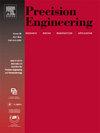Uncertainty analysis and optimization of contact stress for the centering surface in aviation splines considering surface topography
IF 3.5
2区 工程技术
Q2 ENGINEERING, MANUFACTURING
Precision Engineering-Journal of the International Societies for Precision Engineering and Nanotechnology
Pub Date : 2025-04-11
DOI:10.1016/j.precisioneng.2025.04.008
引用次数: 0
Abstract
The centering surfaces of aviation splines (CSAS) are critical for maintaining alignment and stability in aero-engine rotor systems. Misalignment of CSAS triggers excessive wear, unstable torque transmission, and heightened safety risks. In this study, the deterministic contact mechanics model is established based on the fractal theory to predict the mean contact stress (MCS) of CSAS. Then, the interval model of MCS is derived based on the Chebyshev polynomial expansion and the deterministic contact model, and the constructed model is verified by experimental results. Additionally, the multi-objective uncertainty optimization model was proposed to determine the optimal design strategy of CSAS, with the optimization goal of minimizing both the upper bound of MCS and the uncertainty coefficient. Finally, the uncertainty analysis of MCS is carried out, and optimization results are also discussed in detail. Results indicate that the upper bound of MCS is sensitive to topography parameters and the radial offset, and the optimized solution ensures the upper bound of MCS remains within the safety margin while significantly enhancing system robustness. This study provides effective theoretical guidance for improving the design of centering surfaces and enhancing the load-bearing capacity of aviation splines.
考虑表面形貌的航空样条定心面接触应力的不确定性分析与优化
在航空发动机转子系统中,航空花键对中面是保证系统对准和稳定的关键。CSAS的不对中会导致过度磨损,扭矩传递不稳定,增加安全风险。本研究基于分形理论建立了确定性接触力学模型,预测了CSAS的平均接触应力。然后,基于Chebyshev多项式展开和确定性接触模型推导了MCS的区间模型,并通过实验结果对所构建的模型进行了验证。提出了多目标不确定性优化模型,以MCS上界最小和不确定性系数最小为优化目标,确定了CSAS的优化设计策略。最后,对MCS进行了不确定性分析,并对优化结果进行了详细讨论。结果表明,MCS上界对地形参数和径向偏移敏感,优化后的方案使MCS上界保持在安全裕度范围内,同时显著增强了系统的鲁棒性。该研究为改进对中曲面的设计,提高航空花键的承载能力提供了有效的理论指导。
本文章由计算机程序翻译,如有差异,请以英文原文为准。
求助全文
约1分钟内获得全文
求助全文
来源期刊
CiteScore
7.40
自引率
5.60%
发文量
177
审稿时长
46 days
期刊介绍:
Precision Engineering - Journal of the International Societies for Precision Engineering and Nanotechnology is devoted to the multidisciplinary study and practice of high accuracy engineering, metrology, and manufacturing. The journal takes an integrated approach to all subjects related to research, design, manufacture, performance validation, and application of high precision machines, instruments, and components, including fundamental and applied research and development in manufacturing processes, fabrication technology, and advanced measurement science. The scope includes precision-engineered systems and supporting metrology over the full range of length scales, from atom-based nanotechnology and advanced lithographic technology to large-scale systems, including optical and radio telescopes and macrometrology.

 求助内容:
求助内容: 应助结果提醒方式:
应助结果提醒方式:


